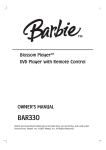Download SMC Networks SMC EZ Connect SMCHT-ETH User's Manual
Transcript
Copyright • Information furnished by SMC Networks, Inc. (SMC) is believed to be accurate and reliable. However, no responsibility is assumed by SMC for its use, nor for any infringements of patents or other rights of third parties which may result from its use. No license is granted by implication or otherwise under any patent or patent rights of SMC. SMC reserves the right to change specifications at any time without notice. Copyright © 2005 by SMC Networks, Inc. 38 Tesla Irvine, CA 92618 All rights reserved. Trademarks: • SMC is a registered trademark; and EZ Connect is a trademark of SMC Networks, Inc. Other product and company names are trademarks or registered trademarks of their respective holders. Table of Content Chapter 1: Introduction………………………………………………………………...3 Features and benefits………..…….…………………………………………3 Packaging Contents...….…….….……………………………………………3 System Requirements.………..……………………………………………..3 Panel: Front and Back……….………………………………………………..3 Chapter 2: Installation………………………………………………………………....5 Overview……………………………………………………………………………..5 Running the InstallShield Wizard………………..……………………..5 Hardware Setup…………..………………………………..…………………..5 Chapter 3: Configuration……………………………………………..10 Overview…………………………………………………………………………….10 Diagnose Powerline Network…………………………….……………..10 • Part 1: Diagnose a local HomePlug device………….…10 • Part 2: Diagnose a Network HomePlug device……….11 Setting up Security on a Local HomePlug device……………..12 Setting up Security on a Network HomePlug device…………13 Appendix A: Troubleshooting……………………………………………………...14 Appendix B: IP Addressing…………………………………………………….……..15 What’s an IP address?............................................15 Dynamic IP addressing…………………………………………….…………15 Static IP addressing……………………………………………………………15 Appendix C: Glossary……………………………………………………………….….16 Appendix D: Product Specification…………………………………………...18 Appendix E: Compliances…………………………………………………………..…19 * Please refer to back cover of the manual for all contact/support information 2 CHAPTER 1 | Introduction Congratulations on your purchase of an EZ Connect™ 85Mbps Turbo Powerline to Ethernet Desktop Adapter (SMCHT-ETH). SMC is proud to provide you with a powerful yet simple communication device for creating a Powerline network to extend the range of your wired or wireless network. The SMC Homeplug Turbo Powerline to Ethernet Adapter provides up to 85Mbps bandwidth over home AC wiring and since the home power lines are the most pervasive medium in households with multiple outlets in every room, the HomePlug Turbo Ethernet Adapter allows multiple home desktops and notebooks to be networked to share internet connection, printers, files, and play games without any additional wiring. The installation of the Ethernet Adapter only requires that a 10/100Mbps Network Adapter is installed on the computers. This makes the HomePlug Turbo Ethernet Adapter compatible with any device including Mac, Windows, and UNIX machines. Features and Benefits • • • • • • • • EZ Configuration Utility for Windows – Works on both Windows and Mac based PCs Plug and Play installation – works out of the box Extends the range of your wired or wireless network Save time and money by using existing home wiring – no need to run CAT-5 cabling Ideal solution for connecting your Game Console system to the Internet to play online games Up to 85 Mbps bandwidth over standard home power lines 56-bit DES encryption for data security HomePlug Powerline Specification 1.0 Turbo complaint Package Contents Before installing the EZ Connect™ Powerline to Ethernet Desktop Adapter, verify that you have the items listed under “Package Contents.” Also be sure that you have the necessary cabling. If any of the items are missing or damaged, contact your local SMC distributor. • EZ Connect™ 85Mbps Turbo Powerline to Ethernet Desktop Adapter • Powerline Cord • One CAT-5 Ethernet cable • CD with User Guide and EZ Configuration Utility • Quick Installation Guide If possible, retain the carton and original packing materials in case there is a need to return the product. System Requirements • An Ethernet-enabled device, such as a PC or game console system. • Windows-based PC to use the EZ Configuration Utility • CD-ROM* Note: A CD-ROM drive is only required if you want to install the EZ Configuration Utility from EZ Install CD. This utility can also be downloaded from www.smc.com 3 Panel Front Power LED HP LED On Off On Off Eth LED: Act / Link for Ethernet Blinking Lit Receive Power Did not receive Power Detect other HomePlug devices on the same powerline network Did not detect any other HomePlug devices on the same powerline network Ethernet activity detect Ethernet connection Back 4 Chapter 2: Installation Overview The installation of the SMCHT-ETH EZ Connect™ 85Mbps Turbo Powerline to Ethernet Adapter will only take minutes. No setting up for long wires through out the house. Just simply install the software CD that is included in the box and after installation, physically plug the unit into the computer and the wall outlet. Users will have options to adjust its security functions and the platform of the network once everything is installed properly. For further assistance, please read our Frequently Asked Questions section. Running the InstallShield Wizard Please insert the CD into your CD-ROM and wait a moment for the setup screen to come up. If the CD-ROM does not auto run the CD, please click on ‘Start’ at the bottom left of your screen (for most Microsoft Windows) and go to ‘Run’. Type in: (CD Drive Letter):\utility\setup.exe and click ‘OK’. Once the software is loaded, it will display a dialog box below: Please click on ‘Next’ to continue the installation. 5 On this screen you will be asked to input the User Name and Organization. It is not crucial to the device itself so enter as desired. The ‘Install this application for’ will work under the circumstances when multiple logins are desired. For example: Check ‘Only for me’ if the user wishes only he/she can use the utility with that particular account. For those without multiple accounts or wishes to allow all users to access the utility choose ‘Anyone who uses this computer (all users)’. When finished, click the ‘Next’ button to continue. This section allows you to change the default directory where the program is installed. If you don’t want to change the directory, click ‘Next’ to continue the installation process. 6 This section allows a user to go ‘Back’ or ‘Install’ the utility. In case if the user wishes to change the previous options, click ‘Back’ to go back to previous options and change the settings. If not, continue and click the ‘Install’ button. This screen shows the progress of the installation. 7 This screen shows that the installation was completed successfully. Click on ‘Finish’ to exit the wizard. Now its time to setup your hardware connections please refer to the next diagrams. Hardware Setup 1. Plug your network cable into the computer’s RJ-45 network adapter port. 2. Plug the other end of your network cable into the RJ-45 port located at the back of the HomePlug Turbo Ethernet Adapter. 3. Plug your power connector of your power cable into the power connector at the back of the HomePlug Turbo Ethernet Adapter. 8 4. Plug the power plug of your power cable directly into a power outlet on the wall **Note: ** Do not plug the device into a UPS or power strip with surge protection. The HomePlug Turbo Ethernet Adapter has its own power filter for protection against surges. See below for example. Power Outlet Cat-5 Ethernet Cable Power Cord 9 Network Interface Card: Computer Cat-5/ RJ-45 Chapter 3: Configuration Overview The HomePlug device uses 56-bit DES encryption to block outside access. The key is set by using the HomePlug Configuration Utility on the CD. By default, the protection is enabled. However, it is recommended that you change the default network password. All your HomePlug devices must use the same network password in order for the computers to be networked. Make sure that all devices are loaded with the same network password. Diagnose Powerline network 1. Diagnose a Local HomePlug Device Double click the PowerPacket Utility icon on your desktop to open this utility screen shown below The Main tab shows the HomePlug units that are connected to the current computer and other devices on the network. It will also display Mac Address of each device. The utility will refresh the window, when there are changes in devices, and it will also allow you to connect to different networks if multiple units are connected to your computer. *Note* If the Link Quality is poor, and appears in red, or the Mac Address of any of the units connected to this computer appears to be all 0’s, then you might have a defective unit. Please contact technical support (Appendix G) ** *Note* If you do not see ANY unit in the device status and there is a device connected to your computer, try to unplug all devices then plug them back in. Also make sure that the cable connecting your computer to the HomePlug device is the right type and working correctly. If all 10 of this seems to be correct, and you still do not see the device in the Device window, try rebooting your computer. If the problem still persists, please contact technical support (Appendix G). Part 2: Diagnose a Network HomePlug device The Main tab shows all the other HomePlug Units on your powerline network. It will be represented by MAC Address and will also show the available bandwidth to each unit (Units farther away from the current computer might have a lower Data Rate since the distance is farther). If you add or subtract units from your home network, you might want to re-Scan by clicking the “Scan” button. This will rescan the network, and refresh with any changes. **Note** Only units with the same Network Password will be shown. Please check that first to make sure they all have the same network password (Case sensitive). **Note** If the MAC Address of a unit shows all 0’s, this unit might not have a solid connection, or might not connect at all. Please make sure the device was correctly installed and connected. • **Note** If there are Units in your home that you do not see in this Network scan, try to unplug all devices, then plug them back in (Only do this with the Units that is not displayed in the network screen, you don’t have to do this with all units. If the problem persists, try to move the unit closer to this current unit (adjacent plugs on the same wall socket is most preferable). If the problem still persists, the distance might be the issue. 11 Setting Up Security on a Local HomePlug device The Privacy tab will allow you to change the Network Password to the unit that is currently connected to this computer. This network password encrypts all data that is sent from this unit using 56-bit data encryption standard (DES), thus creating a secure home network. **Note** Every unit on your home network MUST have the same Network Password for connectivity to be established throughout your home. The default network password is “HomePlug”. 12 Setting Up Security on a Network HomePlug device The Privacy Tab will allow users to use one primary computer to control the Network Password of all units on the home network. First locate the DEK (Device Encryption Key) Key printed on the bottom of each device then enter this Key into the Device Password area on the Main Tab. Click ‘Add’. This Device Key will then appear in the bottom window. Add all the DEK Keys for each unit in your house. Now you can go back to the Main Tab then change the password remotely from one computer using PowerPacket Utility. This will allow you to change the password from one computer, instead of changing the password individually. **Note** DEK is unique for EACH HomePlug device. To use this feature, you will need to input the DEK for each unit. 13 Appendix A: Troubleshooting Frequently Asked Questions Q. What’s the speed of Turbo HomePlug operating over a standard home power line network? A. Turbo HomePlug operates up to 85 Mbps bandwidth over a standard home power line network. Q. A. What’s the Estimated Range of HomePlug? Approximately 300 meters in wall power lines (one household). Q. Will HomePlug work in any home? A. Any home with copper wiring built-in but on some of the older houses built before 1950 with older wiring, it may not work. Q. A. Will HomePlug signal pass through circuit breakers? Yes, HomePlug signal will have no problem passing through circuit breakers but not through power transformers. Q. A. Does Homeplug work with AC input of 100 – 240V? Yes, HomePlug works with AC input of 100 – 240V. Q. A. Does HomePlug cause any interference with other my other home networking device? No, HomePlug operates in a different frequency band then other power line control devices and can co-exist with technologies as X-10, CEBus, and LONworks. Q. Can my neighbor receive my HomePlug signal? A. It is possible for your neighbor receive your HomePlug signal between two adjacent homes. To prevent this happen, please enable the 56-bit DES security encryption on your HomePlug Device. To do that, you must run the HomePlug Configuration Utility on each Homeplug device in your power line network. This will only allow computers with the same security password to be able to receive information. Q. How do I find out what’s my current speed and my signal strength of my HomePlug device? A. You can find this information by using HomePlug Configuration Utility. Q. One of the Powerline LEDs doesn’t light up after I plug the HomePlug directly into a wall outlet? A. Test that wall outlet with other electrical devices first to make sure the wall outlet is working properly. Then plug your HomePlug device again. If the same problem happens again, plug both HomePlug units into adjacent sockets and see if the LEDs light up. Q. A. The Ethernet LED doesn’t light up on my HomePlug Turbo Ethernet Adapter? If the Ethernet LED doesn’t light on your HomePlug Turbo Ethernet Adapter, it’s most likely because the Ethernet port of the HomePlug does not detect a LAN connection. Check your Ethernet adapter on your computer and make sure its enable and working properly. Also, check to see if the Ethernet cable is the correct type, connected, and working properly. 14 Q. A. I can’t connect to internet and other computers on my powerline network? 1. Check to see if your IP address and TCP/IP protocol are set up properly for all the computers on your power line network (Appendix B) and try to ping your gateway (Appendix B). 2. Check to see if HomePlug Configuration Utility can detect all other HomePlug device on your power line network. Try plugging both HomePlug units into adjacent sockets and see if the lights light up. Q. How many HomePlug devices do I need to setup a powerline network? A. You need two or more HomePlug devices to setup a powerline network. Q. Do I have to install the HomePlug Configuration Utility on every single computer to see if the HomePlug Turbo Ethernet Adapter working properly? A. No. The HomePlug Configuration Utility is a utility to diagnose or setup encryption for HomePlug device. Since HomePlug Turbo Ethernet Adapter is a fully plug & play device, no driver require to install. So technically speaking, the HomePlug Configuration utility is not a requirement to install on your computer. Your HomePlug Turbo Ethernet Adapter will still work properly even if you install the utility, setup the encryption, and delete it from your computer. Q. How many HomePlug Turbo Ethernet Adapters that I can install into same Local Area Network? A. Up to 16 HomePlug Turbo Ethernet Adapters can be installed in one same password powerline network. Appendix B: IP Addressing What is an IP Address? IP Stands for Internet Protocol. An IP Address is the identifier where other computers on the network can contact your computer, when you are connected to the network using the TCP/IP protocols. The format of IP addresses are 32bit numerical addresses in 4 groups of 3. It ranges from 0-255 (For example: 255.255.255.255). This number allows your computer to be unique on the same network and enables you to communicate with other computers on the network. Dynamic IP Addressing Dynamic IP Addressing is when the computer is automatically be assigned to an IP Address. This IP Address is unique for each computer on the network. Static IP Addressing Static IP Addressing is when the computer is assigned a preconfigured IP Address. This Address will never change and will always be the same. This scheme should be used if you want to keep the same settings on each computer all the time. If the subnet of the network changes (subnet is the first 3 groups of the IP), the subnet of the static computer must change also. 15 Appendix C: Glossary Default Password A password set by the manufacturer that is unique to each device and is used to generate a Default Encryption Key (DEK). The DEK is used only for the purpose of encrypting management commands that change the NEK so that the NEK is never sent in the clear over the powerline. DHCP Dynamic Host Configuration Protocol is a method in which IP addresses are assigned by server dynamically to the clients on the network. DHCP is used for Dynamic IP Addressing and requires a dedicated DHCP server on the network. Encryption Key (EK) 64-bit pattern generated by a key derivation function. An EK is used in an encryption algorithm to add security to transmissions between HomePlug devices in a logical network. Ethernet Ethernet is a 10/100Mbps network that runs over dedicated home/office wiring. Users must be wired to the network at all times to gain access. Gateway A gateway is a hardware and software device that connects two dissimilar systems, such as a LAN and a mainframe. In Internet terminology, a gateway is another name for a router. Generally a gateway is used as a funnel for all traffic to the Internet. IEEE The Institute of Electrical and Electronics Engineers. The IEEE describes itself as “the world’s largest technical professional society—promoting the development and application of electro technology and allied sciences for the benefit of humanity, the advancement of the profession, and the wellbeing of our members.” Local Area Network (LAN) A LAN is a group of computers, each equipped with the appropriate network adapter card connected by cable/air, that share applications, data, and peripherals. All connections are made via cable or wireless media, but a LAN does not use telephone services. It typically spans a single building or campus. Logical Network Two or more HomePlug devices that share a common Network Encryption Key (NEK) and that communicate with encrypted transmissions. Network A network is a system of computers that is connected. Data, files, and messages can be transmitted over this network. Networks may be local or wide area networks. Network Password A password set by the user that generates the NEK and defines the user’s logical network. 16 RJ-45 A connector similar to a telephone connector that holds up to eight wires used for connecting Ethernet devices. Router Protocol-dependent device that connects subnet works together. Routers are useful in breaking down a very large network into smaller sub networks; they introduce longer delays and typically have much lower throughput rates than bridges. Powerline Networking Data transmission over powerlines. Password Sequence of characters that serves as input to a key derivation function that generates an Encryption Key (EK). Protocol A protocol is a standardized set of rules that specify how a conversation is to take place, including the format, timing, sequencing and/ or error checking. Static IP Addressing A method of assigning IP addresses to clients on the network. In networks with Static IP address, the network administrator manually assigns an IP address to each computer. Once a Static IP address is assigned, a computer uses the same IP address every time it reboots and logs on to the network, unless it is manually changed. Transmission Control Protocol / Internet Protocol (TCP/IP) TCP/IP is the protocol suite developed by the Advanced Research Projects Agency (ARPA). It is widely used in corporate Internet works, because of its superior design for WANs. TCP governs how packet is sequenced for transmission the network. The term “TCP/IP” is often used generically to refer to the entire suite of related protocols. Wide Area Network (WAN) A WAN consists of multiple LANs that are tied together via telephone services and / or fiber optic cabling. WANs may span a city, a state, a country, or even the world. 17 Appendix D: Product Specification Below is an outline of the Technical Specifications for the EZ Connect Powerline to Ethernet Desktop Adapter (SMCHT-ETH) Standards: HomePlug v1.01 compatible IEEE 802.3 10BASE-T Ethernet Interface: RJ-45 (10BASE-T Ethernet) Electrical plug (Powerline) LEDs: Power (PWR) HomePlug LINK/ACT (HP) Ethernet (ETH) Power Input: 100-240VAC @ 50~60Hz (internal) 0.15A Security: 56-bit Data Encryption (DES) with Dynamic Key Management Protocols: Forward Error Correction (FEC) Automatic Channel Adaptation Software: Device Detect/Diagnostic DEK Password Setup for Local and Remote Device Supports Windows 98SE, 2000, Me, NT, XP Mac OS 9.x and OS X 10.1.x Operating Temperature: 32ºF to 104ºF (0ºC to 40ºC) Operating Humidity: 10% to 90% Non-Condensing Frequency: 4.3 MHZ – 20.9 MHZ Modulation: OFDM Symbol Modulation, Modulation Schemes: DQPSK, DBPSK, ROBO Carrier Modulation Dimensions: 3.05 x 4.53 x .98 in (77.5 x 115 x 25mm) Weight: 4.59oz (130g) Certifications: FCC Part 15 Class B CE UL Certified Warranty: Limited Lifetime 18 Appendix E – Compliances FCC STATEMENT This equipment has been tested and found to comply with the limits for a Class B digital device, pursuant to Part 15 of the FCC Rules. These limits are designed to provide reasonable protection against harmful interference in a residential installation. This equipment generates uses and can radiate radio frequency energy and, if not installed and used in accordance with the instructions, may cause harmful interference to radio communications. However, there is no guarantee that interference will not occur in a particular installation. If this equipment does cause harmful interference to radio or television reception, which can be determined by turning the equipment off and on, the user is encouraged to try to correct the interference by one of the following measures: • Reorient or relocate the receiving antenna • Increase the separation between the equipment and device • Connect the equipment to an outlet other than the receiver’s • Consult a dealer or an experienced radio/TV technician for assistance This device complies with Part 15 of the FCC Rules. Operation is subject to the following two conditions: (1) This device may not cause harmful interference, and (2) this device must accept any interference received, including interference that may cause undesired operation. FCC Caution: Any changes or modifications not expressly approved by the party responsible for compliance could void the user's authority to operate this equipment. IMPORTANT NOTE: FCC Radiation Exposure Statement This equipment complies with FCC radiation exposure limits set forth for an uncontrolled environment. This equipment should be installed and operated with a minimum distance of 20 centimeters (8 inches) between the radiator and your body. This transmitter must not be colocated or operating in conjunction with any other antenna or transmitter. 19 FOR TECHNICAL SUPPORT, CALL: From U.S.A. and Canada (24 hours a day, 7 days a week) (800) SMC-4-YOU; Phn: (949) 679-8000; Fax: (949) 679-1481 From Europe : Contact details can be found on www.smc.com INTERNET E-mail address: [email protected] Driver updates: http://www.smc.com/index.cfm?action=tech_support_drivers_downloads World Wide Web: http://www.smc.com/ For Literature or Advertising Response, Call: U.S.A. and Canada: (800) SMC-4-YOU Spain: 34-91-352-00-40 UK: 44 (0) 871 277 98 02 France: 33 (0) 1 55 64 04 55 Italy: 39 02 739 12 68 Benelux: 31 (0) 654 776 790 Central Europe: 49 (0) 89 92861-0 Nordic and Baltics 46 (0) 566 622 83 Eastern Europe: 420 266 794 421 Sub- Saharan Africa: 27 012 661 0232 North West Africa: 34 93 477 4920 CIS: 34 93 477 4920 PRC: 86-10-6235-4958 Taiwan: 886-2-87978006 Asia Pacific: (65) 238 6556 Korea: 82-2-553-0860 Japan: 81-45-224-2332 Australia: 61-2-8875-7887 India: 91-22-8204437 Fax (949) 679-1481 Fax 34-93-477-3774 Fax 44 (0) 1234 831 413 Fax 33 (0) 45 34 68 58 Fax 39 02 739 14 17 Fax 31 (0) 172 242 393 Fax 49 (0) 89 92861-230 Fax 45 (0) 566 622 86 Fax 420 266 794 423 Fax 34 93 471 3374 Fax 34 93 477 3774 Fax 34 93 477 3774 Fax 86-10-6235-4962 Fax 886-2-87976288 Fax (65) 238 6466 Fax 82-2-553-7202 Fax 81-45-224-2331 Fax 61-2-8875-7777 Fax 91-22-8204443 If you are looking for further contact information, please visit www.smc.com. Model Number: SMCHT-ETH 38 Tesla Irvine, CA 92618 Phone: (949) 679-8000










































